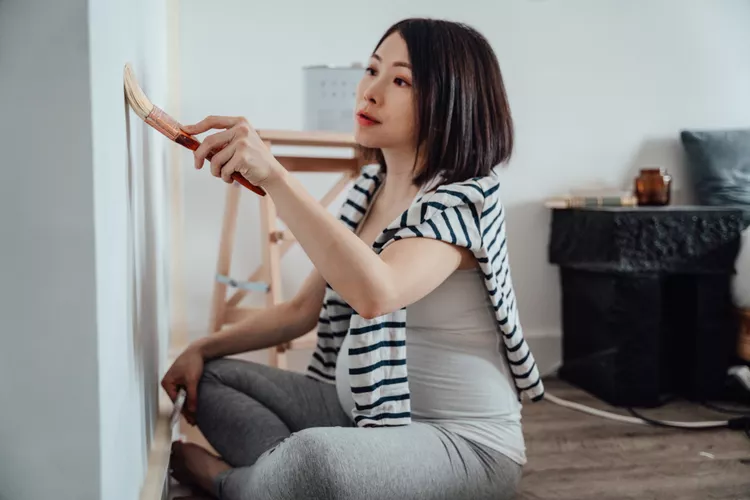If you’re currently expecting, you might be wondering if it’s safe to paint while pregnant. We turned to experts to learn more.
When you’re pregnant, the urge to feather your nest is next-level strong. That hormonal call often includes creating the adorable soothing, calming, and comforting nursery of your dreams—which also sometimes means painting.1
Typically, pregnant people are warned not to paint if at all possible, but where did this pregnancy rule come from, and is it still relevant in 2023 with so many advances in paint formulas? If you’re curious about the safety guidelines for painting while pregnant, here’s what to know before picking up the paintbrush.
What to Know About Painting While Pregnant
Although painting a room while pregnant is relatively low risk, it’s always a good idea to exercise caution—especially because there are no studies about the potential effects on a fetus. “The common rule of avoiding painting while pregnant is to ensure the safety of the mother and unborn baby from the risk of paint fumes,” says Monte Swarup, MD, FACOG, board-certified OB-GYN and founder of Vaginal Health Hub.
You should take into account a few things: the kind of paint you’re using, what’s in it, how long you’re going to be exposed to the fumes, and the adequacy of ventilation. “There are rules around painting while pregnant due to the potential exposure to harmful chemicals and fumes present in some paints,” explains Shandra Scruggs, a labor and delivery nurse, doula, and founder of Simply Birthed.
When in doubt, check the labels before getting to work. “Zero-VOC (volatile organic compounds) [paints] are considered the best to use while pregnant,” says Dr. Swarup, adding, “Acrylic or latex paints that are water-based are better than oil-based; oil paints contain solvents that can be harmful.”
Dr. Swarup also recommends avoiding paint containing ethers, biocides, and ethylene glycol. You should definitely stay away from industrial paint and avoid scraping, stripping, or sanding any paint that may pre-date lead regulations of the 1970s, given that lead can be dangerous for both the pregnant person and the developing fetus.23
What Risks Are Associated With Painting While Pregnant?
If you deal with asthma or other respiratory issues, you may want to skip the painting entirely and leave it to your partner, friends, or other family members. “Exposure to paint fumes and volatile organic compounds (VOCs) can exacerbate respiratory issues, leading to breathing difficulties and potential harm to both the pregnant woman and the baby,” says Scruggs. “Additionally, women with a history of allergies or skin sensitivities may experience adverse reactions to certain paint products, making painting unsafe during pregnancy.”
Scruggs notes that potential side effects can include headaches, dizziness, and skin irritation. In short, if you have any pre-existing health conditions that could be worsened by exposure to paint fumes, stay away from the baby blue paint.
As for potential effects on your baby, as noted above, there’s not a lot of studies out there that can determine what those risks might be. While the American Pregnancy Association states that household painting is a very low exposure level, most health care providers will recommend you get someone else to do the painting while you’re expecting—especially in the pivotal first trimester.4
Tips for Painting Safely While Pregnant
If you really, really love to paint or can’t find anyone to do the work for you, there are a few ways to make your decor dreams come true while still prioritizing safety. However, be sure to talk with an OB-GYN or health care provider before you get started.
As for ingredients, be sure you’re using a low-VOC or zero-VOC paint formula to minimize your exposure to potentially harmful chemicals. (The trendy and adorable brand Clare Paint offers zero-VOC paint.) Additionally, minimize exposure to latex paints that contain ethylene glycol ethers and biocides, along with steering clear of oil-based paints.5
Next, open those windows! “Ensure good ventilation in the painting area to reduce inhalation of fumes,” advises Scruggs. “Take breaks and paint in short sessions to avoid prolonged exposure.” She also recommends wearing gloves and a mask to minimize contact with the fumes.
Be sure you’re not overdoing it physically, too. Take breaks and move into the fresh air frequently. “Opt for painting projects that involve minimal physical strain,” says Scruggs. “Avoid climbing ladders or working in awkward positions.” And don’t forget to stay hydrated while you work—just leave your water bottles and cups in a different room.6
Alternatives to Painting While Pregnant
You can absolutely doll up baby’s room without a fresh coat of paint! Here are some fun ideas for a no-paint nursery:
- Consider livening up the space with stick-on wallpaper.
- Get creative with art. Hang photos, prints, and paintings all over the room to add lots of color and texture for baby to look at.
- Add visual drama with rugs, throw pillows, curtains, and lamps.
- Hang mirrors, cute floating shelves, or wall décor.
- Choose fun and colorful nursery furniture, including a mobile.



